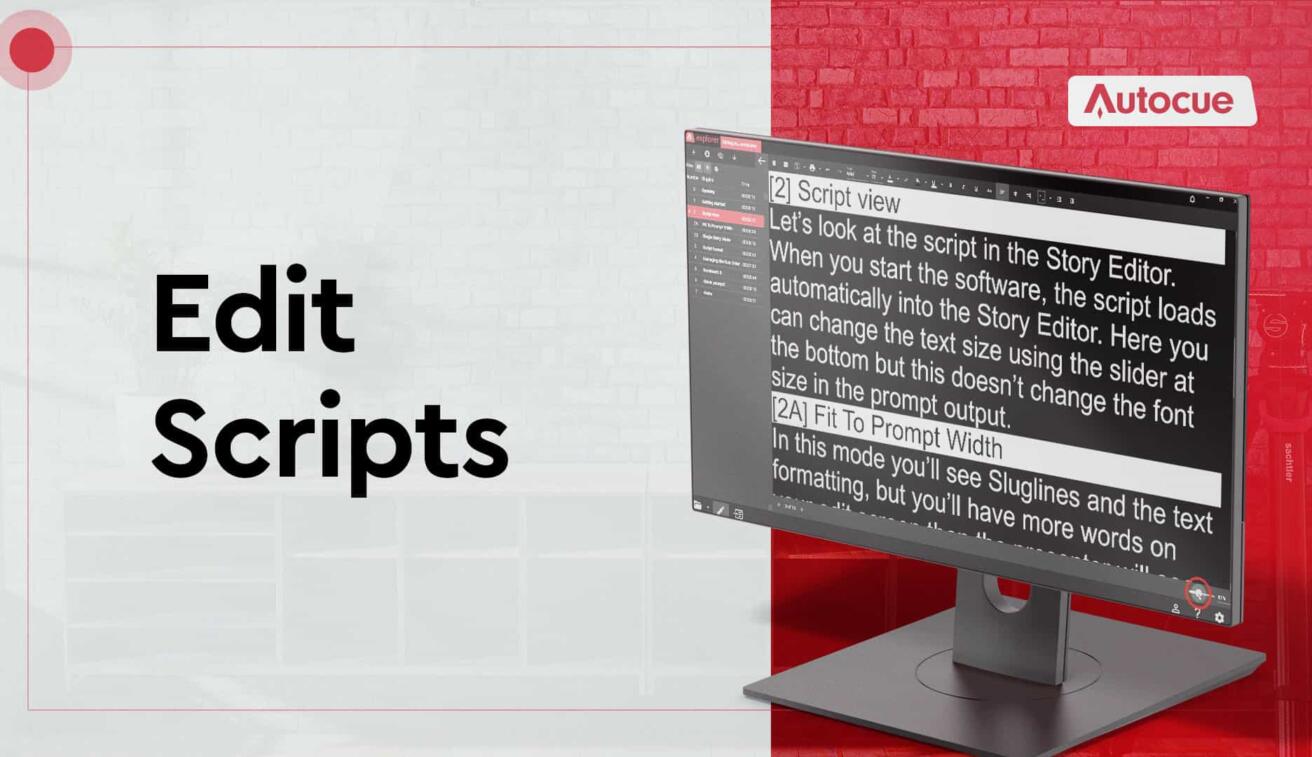Video Transcript
As you become more familiar with prompting software, you can customise the way you work with your scripts. Hi, I’m Matt and in this video, we’ll look at Script Editing, Run Order Management, Bookmarks and some handy shortcuts, to help you manage scripts like a pro. Ready? Cue titles!
1. Getting started
You already know how to create and prompt a script in Autocue Explorer. If you don’t, check out our ‘Getting started with Autocue Explorer’ video before you continue. I’ll wait. OK, let’s open a script I made earlier and look at how to customise the way we operate.
2. Script view
Let’s look at the script in the Story Editor. When you start the software, the script loads automatically into the Story Editor. Here you can change the text size using the slider at the bottom but this doesn’t change the font size in the prompt output. In this mode you’ll see Sluglines and the text formatting, but you’ll have more words on your edit screen than the presenter will see in the prompter. If that’s confusing, or you just want to see what the presenter will see while you’re editing click the ‘Fit to Prompt Width’ icon in the toolbar and choose your preferred text size. Autocue Explorer will remember your settings and apply them to your next session.
If you only want to see one story in the run order at a time, select the ‘Single Story Mode’ icon in the toolbar. Make your edits and then navigate to other stories using the arrows at the bottom, or by clicking on the story list in the run order.
3. Script format
Once your story editor pane looks good, you can move on to editing the text. The Sluglines and script text have a standard format that’s determined in the settings – watch our video on ‘customising settings’ for more info.
You can make individual format changes using the story editor toolbar. The toolbar should feel familiar and, unlike the script view functions, whatever you do here will be on the prompt output. Highlight text to change font, size, and colour. You can make the text bold, italic or underlined. If you want to get someone’s attention, you can force upper case anywhere in the script or change the background colour. You can also align the text and add bullets. Script edits are simple, so just have a go to see how easy it is.
4. Managing the Run Order
Now let’s look at the Run Order. If you have a simple script, you might not need to manage the run order at all. Click the arrow at the top of the run order to hide it and move on! But the run order can be helpful, so let’s see how to make the most of it.
You’ll see a list of stories in your script, with their number, slugline title and approximate run time. You’ll also see any bookmarks – we’ll get to them later. To remove either of those views, click the icons in the filter. Or, to add even more detail, click the notes icon to add extra descriptions under the story titles.
Double click a story to edit or prompt from there. If you single click on a story, it will highlight in light grey and you can apply actions to the entire story. You can delete the story. – don’t worry, you’ll get a warning and can choose to cancel. You can also cloak or drop the story.
When you cloak a story in the run order, it hides the story from the prompt output. Select the story and then press the ‘Cloak/Uncloak’ icon. Cloaked text will be visible but highlighted in the Story Editor. When you click to prompt, you’ll find the story is removed from the output. Uncloaking reverses the action – simply highlight the story and press the same icon.
When you drop a story, it moves to the end of the run order. This is a quick way of moving stories to the end of the script to use later. You can also reposition stories into any location in the run order by dragging and dropping them.
5. Bookmark it
As an operator, there might be times you want a point in the script to be easy to navigate to for future or regular edits, but you don’t want to break up the story with another slugline or marker visible to the presenter. In this situation, Bookmarks are your friend. Go to the location in the script editor and right-click and select ‘Toggle Bookmark’, or hit Alt plus M. The line of text will highlight in the story editor and a bookmark reference will add to the run order.
To move between bookmarks, you can select from the run order by double clicking, or while you’re editing, you can hit Alt plus N as a shortcut to get to the next bookmark and Alt plus P to get to the previous bookmark.
6. Quick prompt!
While we’re talking shortcuts, there’s one other important shortcut that you need to know. If you’re busy making edits with your keyboard and the presenter wants to see the script, there’s a shortcut to get you there without jumping for the mouse. Clicking F9 gets you straight into prompt mode and ready to go with no fuss.
The main takeaway from this video should be that there’s nothing to be afraid of! Autocue Explorer software is developed using years of experience to be fast and friendly to use. We believe everyone should benefit from prompting and now you have all the info you need to edit your script to perfection. Thanks for watching. Until next time. Stay on cue.
